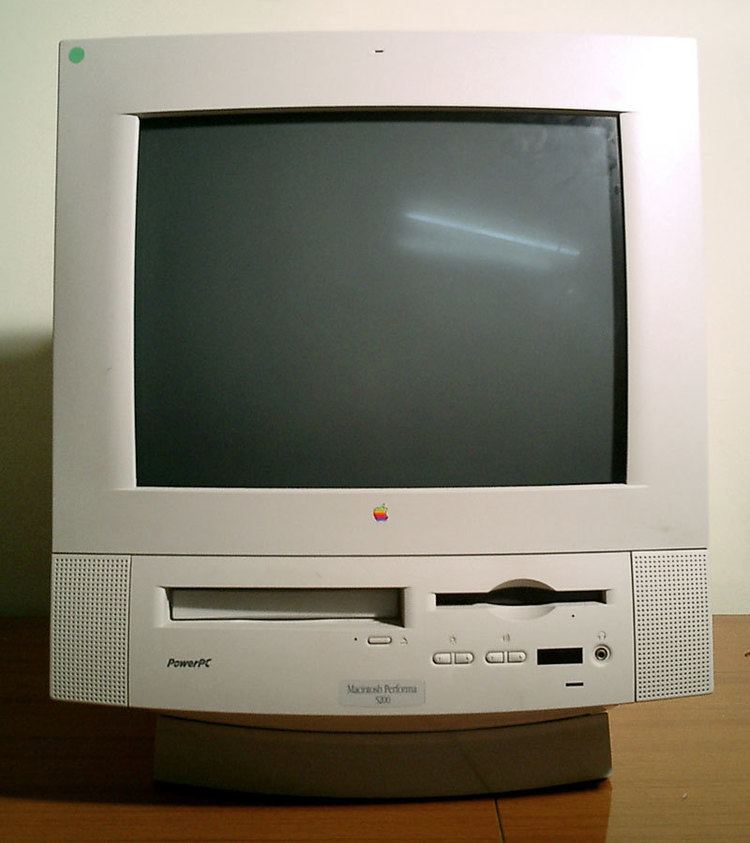 | ||
The Macintosh Performa series is Apple Computer's consumer product family of Apple Macintosh personal computers sold through department stores and mass-market retailers from 1992 until 1997, when it was superseded by the Power Macintosh 5x00 series. The Performa series was not a new line of computers, but simply renamed models from Apple's regular line of computers—such as Quadra, Centris, LC, and Power Macintosh—sold by authorized Apple resellers. The initial series of models consisted of the Performa 200, based on the Macintosh Classic II, the Performa 400, based on the Macintosh LC II, and the Performa 600, based on the Macintosh IIvx.
Contents
Marketing theory
With a strong education market share throughout the 1990s, Apple wanted to push its computers into the home, with the idea that a child would experience the same Macintosh computer both in the home and at school, and later grow to use Macintosh computers at work.
Before the existence of the Apple Store, Apple sold computers through authorized resellers, either brick and mortar or mail order. A typical reseller sold Macintosh computers to professionals, who purchased high-level applications and required performance and expansion capabilities. Consumers, however, purchased computers based on the best value, and weren't as concerned about expansion or performance. Apple wanted to sell their computers through department store chains (such as Sears), but this would conflict with existing authorized reseller agreements, in which a geographic area had only one reseller.
To prevent these conflicts, Apple split the Macintosh line into professional and consumer models. The professional line included the Classic, LC, Centris, Quadra, and Power Macintosh lines, and continued to be sold as-is (e.g., no consumer software bundles or limited features). The consumer line included computers similar to the professional line labeled "Performa".
The Performa line was marketed differently from the professional line. To satisfy consumer-level budgets, the computers were sold bundled with home and small business applications. Most models were also bundled with a keyboard, mouse, an external modem and either a dot-29 or dot-39 pitch shadow mask CRT monitor (professional models were sold à la carte with keyboard and mouse bundles chosen by the dealer or sold separately; monitors sold with higher end Macintosh models used Trinitron tubes based on aperture grille technology.). Software bundles usually included ClarisWorks, Quicken, a calendar/contact manager such as Touchbase and Datebook Pro, America Online, Apple's At Ease child-safe interface, educational software such as American Heritage Dictionary, The New Grolier Multimedia Encyclopedia, TIME Almanac (on models equipped with a CD-ROM drive), Mavis Beacon Teaches Typing, or Mario Teaches Typing, and a selection of games such as Spectre Challenger, Diamonds, and Monopoly, all pre-installed over a slightly customized version of the Macintosh System software, denoted by a P in the version number (e.g., System 7.1P5).
Although the Performa models resembled their professional counterpart on the system software and hardware level, certain features were tweaked or removed. The Performa 600, for example, lacked the level-2 cache of the Macintosh IIvx it was based on. The Performa versions of the System software also introduced some features that were later included in mainstream system releases, most notably the Launcher. System 7.5 ended the separate Performa releases.
Marketing failure
The Performa marketing strategy failed for a number of reasons. The large number of models was intended to accommodate retailers, who could advertise that they could beat their competitors' price on equivalent models while at the same time ensuring that they did not carry the same models as their competitors, but this also created consumer confusion. To help consumers choose between the options available to them, Apple created "The Martinettis Bring Home a Computer", a thirty-minute infomercial about a fictional family that purchases a Performa computer.
Another factor was that people working at mass-market retail stores lacked the specialized training Apple offered to its dealers. The Performa display models were often poorly taken care of; the demo computers crashed, the self-running demo software not running or the display models not even powered on. Consumers who may have been purchasing their first computer were steered away from the Performas because they "weren't compatible". Apple tried to address the training issue by hiring their own sales people to aid the store sales staff, most of them recruited from Macintosh user groups. Despite this, however, many returned Performa computers could not be serviced properly because the stores were not authorized Apple service centers.
However, most experts attributed the failure to retailers favoring the Microsoft Windows line, especially after the introduction of Windows 95. Computers running Windows were generally cheaper, and encouraged by manufacturer spiffs, advertising co-ops, and other promotion programs. In addition, many stores preferred to sell their own branded white box PCs.
The significant number of nearly identical models across its multiple hardware lines caused Apple to rethink its marketing strategy. The company shrank it considerably, eliminating the entire Performa line in the late 1990s, along with many of the professional models in favor of a "four box" strategy comprising a professional desktop (Blue and White G3), professional laptop (PowerBook), consumer desktop (iMac) and consumer laptop (iBook). When Apple sold its computers through CompUSA retail outlets in the late 1990s, it insisted on a "Store within a store" concept, with Apple and related products displayed and sold in a physically separate location by specialized employees (currently done at select Best Buy stores).
Criticisms
Critics of the Performa line, including some Mac users, argued the Performas were generally underpowered relative to higher-end Mac models. Some critics cited the large and confusing array of different Performa models, some differentiated only by the hard drive size or the software bundle (such as the Performa 475 and 476).
Macintosh-to-Performa comparison
Reference:
* X Denotes multiple variant of the same model (i.e. Performa 630CD and Performa 638CD).
